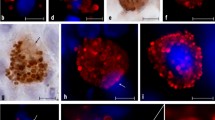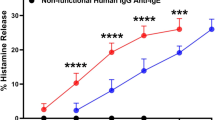Abstract
The enzyme collagenase was used to disperse rabbit lung and liver into their component cells. The resulting cell suspensions contained ca. 6.9% (lung) or 6.5% (liver) mast cells and were used in studies of histamine release without further purification. Both cell suspensions exhibited a low spontaneous release of histamine (ca. 6.6% lung, ca. 7.2% liver). Both cell types responded to challenge with anti-rabbit serum with a maximum release of the amine of ca. 22% (lung) and ca. 45% (liver). Concanavalin A challenge generally resulted in bell-shaped dose response curves, however some lung preparations did not respond. The rabbit cells were refractory to stimulation by Compound 48/80 and dextran. However a dose-dependent release of histamine was elicited after challenge with the detergents cremophor El®, TN (12-hydroxystearic acid polymerized with ethylene oxide, degree of polymerization 15) and the hypnotics Althesin® and propanidid. The maximum release observed depended on which cell preparation had been used. These results further emphazise the functional heterogeneity of mast cells from both different species and from different organs within the same species.
Similar content being viewed by others
References
W. Lorenz and A. Doenicke,Histamine release in clinical conditions. Mt. Sinai J. Med.45, 357–386 (1978).
M. Ennis and W. Lorenz,Modulation of histamine release by fatty acids. A new in vitro model investigating adverse drug reactions in various species. Ann. Fr. Anesth. Réanim.4, 124–128 (1985).
M. Ennis,Histamine release from human pulmonary mast cells. Agents and Actions12, 60–63 (1982).
G. Atkinson, M. Ennis and F. L. Pearce,The effect of alkaline earth cations on the release of histamine from rat peritoneal mast cells treated with compound 48/80 and peptide 401. Br. J. Pharmac.65, 395–402 (1979).
P. A. Shore, A. Burkhalter and V. H. Cohn,A method for the fluorimetric assay of histamine in tissues. J. Pharmac. exp. Ther.127, 182–186 (1959).
W. Lorenz, H. Barth, M. Thermann, A. Schmal, P. Dormann and I. Niemeyer,Fluorometric histamine determination in canine plasma under normal conditions, following application of exogenous histamine and during histamine release by Haemaccel. Hoppe-Seyler's Z. physiol. Chem.355, 1097–1111 (1974).
F. L. Pearce, M. Ennis, A. Truneh and J. R. White,Role of intra- and extracellular calcium in histamine release from rat peritoneal mast cells. Agents and Actions11, 51–54 (1981).
C. F. Code,Histamine in blood, Physiol. Rev.32, 47–65 (1952).
H. Schievelbein and B. Zitzelsberger,Vergleichende Untersuchungen zum Transport von Histamin, 5-Hydroxytryptamin und Catacholaminen. 1. Mitteilung: Freisetzung von biogenen Aminen. Med. exp.11, 239–246 (1964).
C. G. Haining,Histamine release in rabbit blood by dextran and dextran sulphate. Brit. J. Pharmacol.10, 87–94 (1955).
Author information
Authors and Affiliations
Rights and permissions
About this article
Cite this article
Ennis, M., Lorenz, W., Gerland, W. et al. Isolation of mast cells from rabbit lung and liver: Comparison of histamine release induced by the hypnotics althesin® and propanidid. Agents and Actions 20, 219–222 (1987). https://doi.org/10.1007/BF02074674
Issue Date:
DOI: https://doi.org/10.1007/BF02074674




